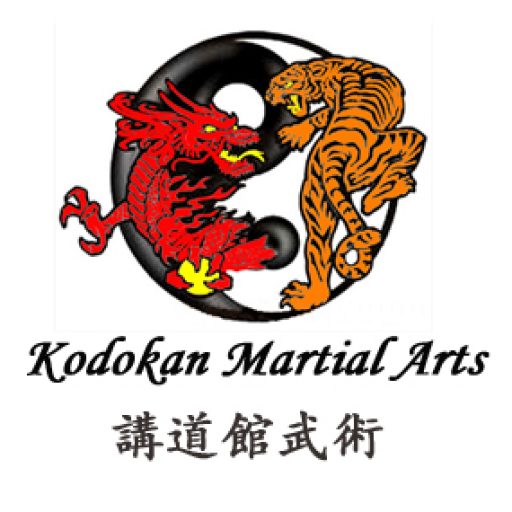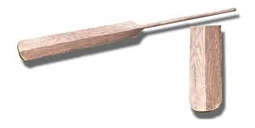Wooden Weapons
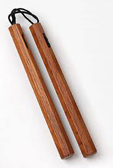 Matayoshi Kobudo students use a varied number of wooden weapons. Some are also a mix, as they contain a blade, as in Kama, or a dagger as in Nunti Bo. They are:
Matayoshi Kobudo students use a varied number of wooden weapons. Some are also a mix, as they contain a blade, as in Kama, or a dagger as in Nunti Bo. They are:
- Bo
- Tunkua
- Nunchaku
- Ueku
- Sansetsu Kon
Those that are mixed will be covered under Metal Weapons, but they consist of:
- Sai
- Nunti Bo
- Kama
- Timbe
- Kuwa
- Manji Sai
Wood Selection
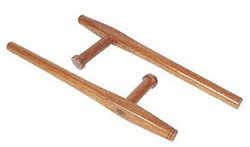 The most common wood for weapons in the UK is Red Oak. It is a heavy wood with good shock resistance. Other suitable woods are:
The most common wood for weapons in the UK is Red Oak. It is a heavy wood with good shock resistance. Other suitable woods are:
- Ash (strong and inexpensive),
- Hickory (very strong),
- White Oak (good wood but has a tendency to warp and may break),
- Purple Heart (very strong, good looking and lively to the touch),
- Kuba (Chinese palm tree).
More exotic woods that can be used are:
- Cocobolo,
- Green Heart,
- Snake Wood,
- Ebony and Lignum Vitae (iron wood) may be used but are rare and expensive.
These exotic woods may be used for smaller weapons such as found in the Tanto, Japanese dagger.
Buying Wooden Weapons
In the UK most weapons are shipped in from Taiwan. These weapons are not ideal as they are mass produced. When you have acquired one of these weapons then always check the following:
- Appearance.
Look down the full length of the weapon. Roll it on the floor. Make sure it rolls true. Check all joins Tunkua, Kama, Rochin, Nunti Bo etc. - Wood.
Check the wood for cracks and splinters. Also check the wood for areas where cracks may have been filled with resin. - “Bend ability”.
Put some weight on the weapon and bend it slightly. If it breaks it is inferior and may have broken whilst in use and caused an injury.
Preparing Wooden Weapons
Most weapons will be unfinished or coated with a varnish. This leaves the weapon lifeless and difficult to handle. As soon as possible sand the weapon down to remove the varnish. Do this by using various grades of sandpaper – coarse to fine depending on the condition of the weapon. A good quality steel wool may also be 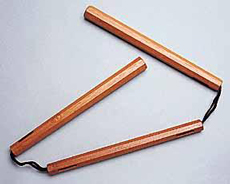 used. Be sure to rotate the weapon and change the length of the strokes so that the sanding is equal. Finally check for cracks or splits. If these are present then do not use the weapon, especially in partner work.
used. Be sure to rotate the weapon and change the length of the strokes so that the sanding is equal. Finally check for cracks or splits. If these are present then do not use the weapon, especially in partner work.
Once the varnish has been removed and the wood is smooth, wipe the wood with a “Tack Cloth” to remove any dust particles left over from sanding. Now apply Linseed Oil, Danish Oil, Tung Oil or equivalent wood nourisher to a rag and rub into the wood. Leave for 10 to 15 minutes and wipe away any surplus oil. Leave to stand overnight. Alternatively weapons can be left in a specially constructed weapons bath and left for a few days, allowing the weapon to be nourished. The grain in the wood should now stand out and the weapon should be alive in the hands.
Maintenance
Wooden weapons tend to dry out very quickly, especially in today’s centrally heated environments. So, every weapon should be looked after correctly. Every 6 to 10 weeks lightly rub the weapon with a light grade sandpaper or steel wool and re-apply the oil or leave in the weapons bath for a few days. Before and after using the weapon wipe it down with a clean cloth. This removes any dirt or oils. Every weapon should have it’s own bag for protection, security and for carriage. This will keep them safe and protect them for contamination. All long weapons, such as the Bo, Nunti and Ueku should be laid flat, stored in a purpose built vertical rack or suspended in it’s carry case. They should never be lent against a wall. This will cause them to warp. Care of weapons is very important especially after use outdoors.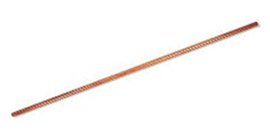
Before using the tunkua, make sure the grip is firmly attached to the main shaft. Quite often, the grips of inferior weapons become loose with use, resulting in potential hazard to the student or other students in the dojo.
Nunchaku should be treated and cared for as all the other wooden weapons. However, particular attention must be made to the string. If the nunchaku is supplied untied, then a good way is to rethread the weapon as shown in the video below. It is tied with a Triple String which will give a strong binding between the two shafts. If the weapon is purchased already tied then consider re-threading the weapon using a good nylon type string. Always before practise check for cracks, and frays in and around the string. Also test the security of the string by giving the nunchaku a strong pull.
How to Triple String Nunchaku
